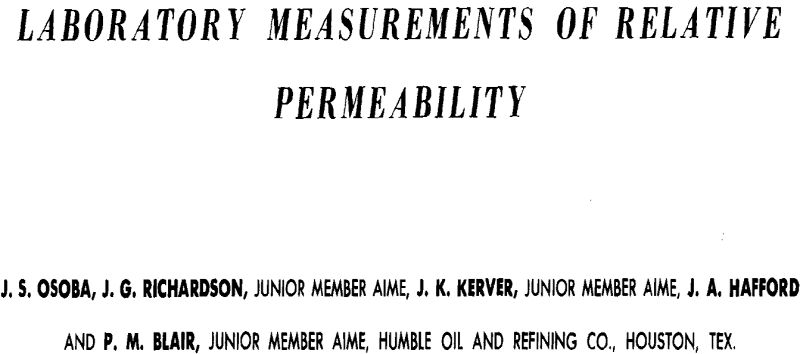Table of Contents
This paper presents the results of laboratory measurements of relative permeabilities to oil and gas on small core samples of reservoir rock by five methods, and describes the influences of such factors as boundary effect, hysteresis, and rate upon these measurements. The five methods used were the “Penn State,” the “single core dynamic,” the “gas drive,” the “stationary liquid,” and the “Hassler” techniques.
In those methods in which the results are subject to error because of the boundary effect, the error may be minimized by the use of high rates of flow. In order to avoid complexities introduced by hysteresis, it is necessary to approach each saturation unidirectionally. Observed deviations of relative permeabilities with rate can be explained as a manifestation of the boundary effect, and disappear as the boundary effect vanishes.
Factors which Influence the Measurement of Relative Permeability
It is necessary that the relative permeability data measured in the laboratory yield the same relative permeability-saturation relationships that would govern the flow of fluids through the sample if it were to occupy its original position in the reservoir. Since the core sample upon which the laboratory measurements are made is not surrounded by similar core material as it was in the reservoir, an error in measuring the relative permeabilities may arise from the “boundary effect” which results from a discontinuity in capillary properties of the system at the effluent end of the core. Again, the rates of fluid flow used in the laboratory measurement of relative permeability may be higher than those which occur in the reservoir: this seeming lack of reproducibility of reservoir conditions has, in the past, caused some uncertainty as to the validity of applications of the laboratory results. Still another influence on the laboratory measurement of relative permeability is that of hysteresis.
Boundary Effect
In the determination of relative permeability in the laboratory by the passage of two immiscible fluids through a core sample, there exists a discontinuity in capillary properties at the outflow end of the core. This discontinuity occurs where the fluids pass abruptly from the rock, a region of finite capillary pressure, into an open receiving vessel, where capillary pressure vanishes. Because of the capillary forces existing within the core, the rock tends to retain the wetting phase at the outflow end. This results in an accumulation of the wetting phase, so that the saturation of that phase at the outflow boundary is maintained at a higher level than through¬out the remainder of the core.
Various investigators have observed and discussed this “boundary effect” in connection with their studies of relative permeability and capillary behavior. Leverett observed in his experimental flow of oil and water through sands that there was a saturation gradient from a relatively high water saturation at the boundary to a lower one at a relatively large distance from the boundary.
Of the various ways in which the boundary effect may be avoided or minimized in the measurement of relative permeability, the most obvious is that of performing all measurements on a section of the core sample far enough removed
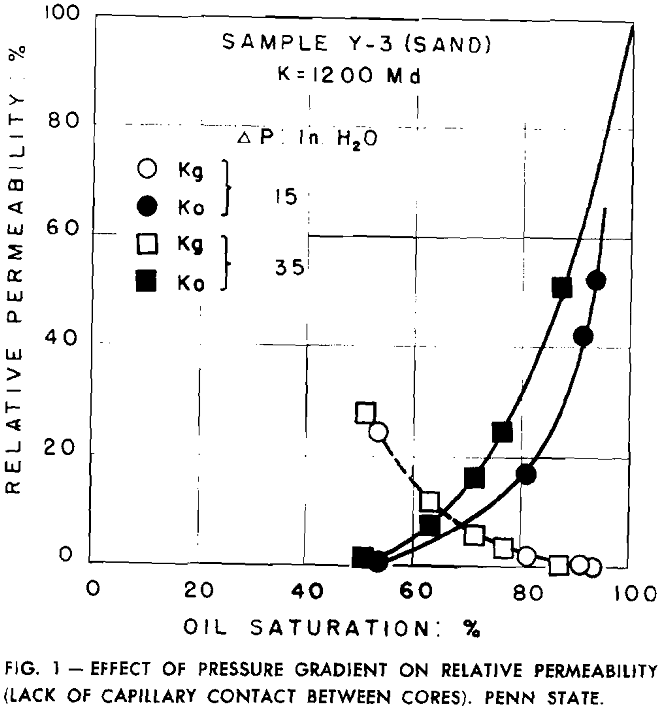
from the outflow end to insure that the saturation gradient in the test section is insignificant. In practice, this may be done by use of a single core only with difficulty. A procedure equivalent in principle consists in placing beyond the test core a core sample of similar material. The boundary effect is then transferred to and confined within the latter core. In this procedure the two must be in capillary contact.
The boundary effect may also be minimized by the use of high rates of flow. It may be shown by theoretical considerations based on d’Arcy’s law, relative permeability-saturation relations, and capillary pressure-saturation relations that the saturation distribution along the core varies for different rates of flow. At low rates of flow the saturation gradient extends over a considerable distance from the outflow end, and at increased rates of flow the gradient extends over shorter distances. It may be concluded that at high rates of flow the error introduced by the boundary effect may be made so small that it will not appreciably affect the measurements of relative permeability.
Hysteresis Effect
Relative permeability-saturation relations are not unique functions of saturation for a given core, but are subject to hysteresis; that is. the relative permeability to a fluid at a

given saturation depends on whether that saturation is obtained by approaching it from a higher or lower value. Since hysteresis does exist, care must be exercised that the relative permeabilities measured in the laboratory are obtained under conditions wherein each saturation is approached in the desired manner.
Procedures and Results of Relative Permeability Measurements
Five procedures for the measurement of relative permeability have been investigated in the work described in following sections. In these techniques the influence of the boundary effect has been avoided or minimized in various ways. Throughout all these investigations, a two-phase system, oil and gas, was used.
The Penn State method, so-called because it was devised at Pennsylvania State College, attempts to avoid the influence of the boundary effect by use of a test core sample between two samples of similar material, the three being in capillary contact. In theory, the boundary effect may thus be confined to the downstream sample, with no saturation gradient existing in the sample under test. The purpose of the upstream core is to act as a mixing section for the two fluid phases.
Relative permeabilities were measured by the Penn State method by use of kerosene and helium as the two fluid phases. The cores were first saturated with the oil, and then oil was allowed to flow through them at a rate that gave a predetermined pressure drop. The gas was then allowed to flow at a very low rate. After the system had reached equilibrium, the test core was removed quickly, and the oil saturation was determined by weighing. The core sections were then reassembled, and flow of both phases was resumed at the
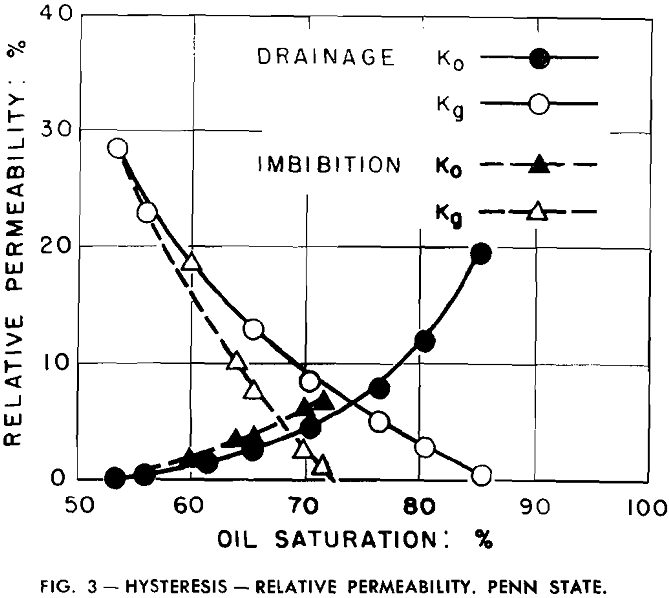
rates which had existed previously. The rate of flow of the oil phase was then decreased slightly, and the rate of flow of the gas was increased simultaneously to maintain the pressure drop across the core at its previous value. After equilibrium had again been attained, the test section was removed and the saturation was determined. This step- wife procedure was repeated until a complete relative permeability curve had been obtained at incremental changes in the fluid saturation.
Much difficulty was encountered initially in relative permeability measurements by the Penn State apparatus when the flow rate was varied over wide limits. In early experiments, the kerosene was presaturated with gas at the pressure at which the kerosene was introduced into the apparatus. With saturated kerosene as the wetting phase, it was observed that the measured relative permeabilities to both oil and gas were erratic. When experiments were conducted with kerosene from which most of the dissolved gases had been removed, the erratic deviations disappeared. A degassed oil phase was accordingly used in all subsequent work.
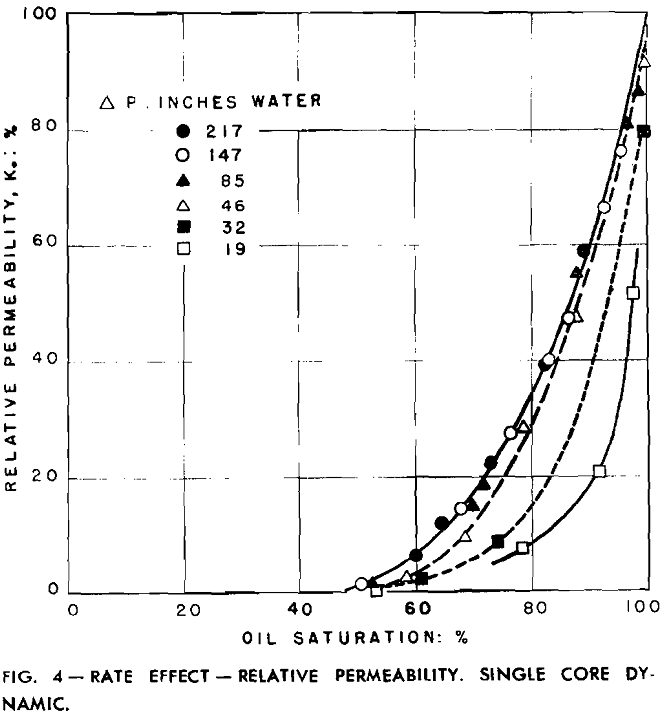
In order to investigate the effect of change of rate of flow on measurements made by this technique, without introducing
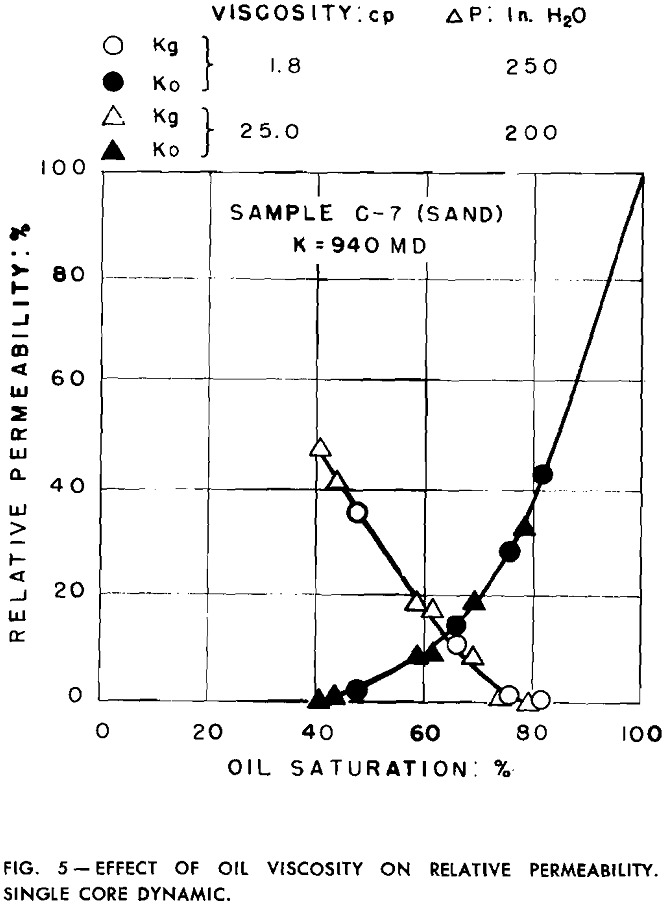
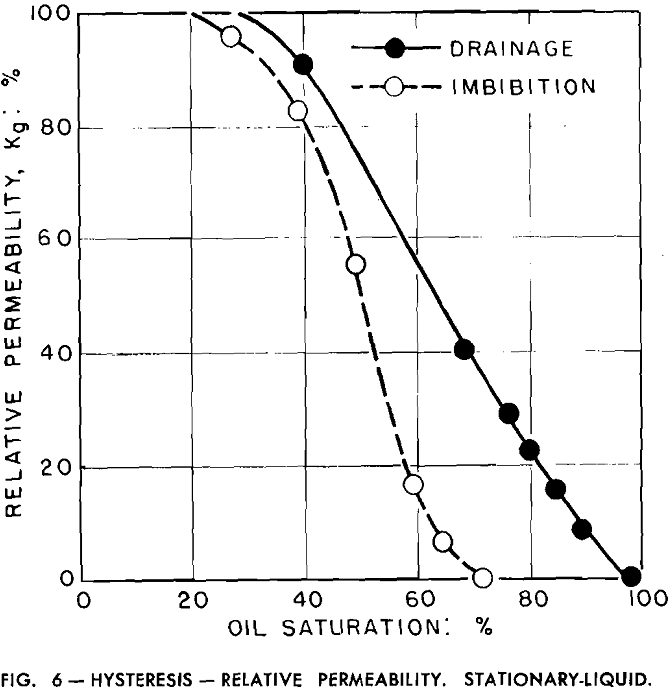
possible complications due to change in pressure drop, a series of measurements was made with oils of various viscosities, flowing under an essentially constant pressure gradient. In these runs the viscosities of the oils ranged from 1.8 to 25 centipoises.
